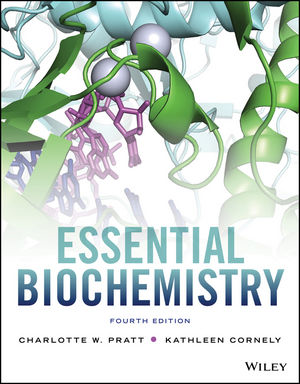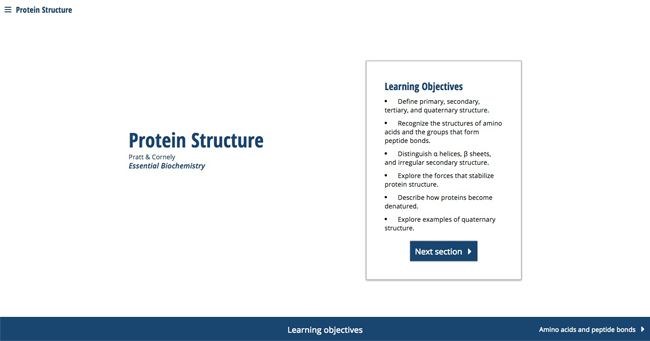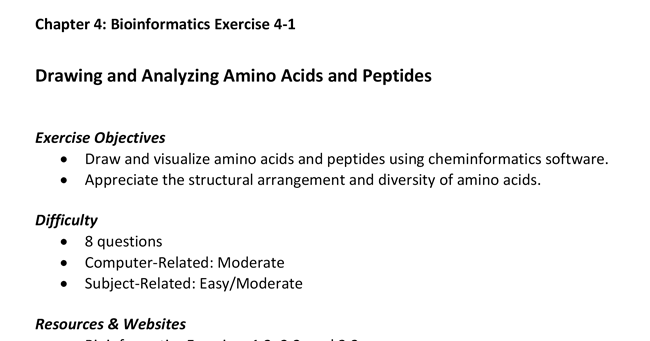
Essential Biochemistry, 4th Edition
By Charlotte Pratt and Kathleen Cornely
Essential Biochemistry, 4th Edition takes a modern approach involving broad but not overwhelming coverage of biochemical facts, focusing on the chemistry behind biology and providing students with practical knowledge and problem-solving opportunities.
WileyPLUS for Essential Biochemistry includes ORION Adaptive Practice that helps students build their proficiency on topics and use their study time most effectively.
Schedule a Demo Sign Up for a Test Drive Adopt WileyPLUSWant to learn more about WileyPLUS? Click Here

Guided Tours help students truly understand concepts that may be difficult to grasp.
The Guided Tours, created by Charlotte Pratt, are multi-part animations that present big picture concepts conveyed through animations, tutorials, and practice.

Students see the connection between theory and applications.
Assignable brief Bioinformatics Exercises written by Rakesh Mogul, Cal Poly Pomona, introduce students to the rich variety of biochemical information and software tools available on the internet, showing them how to mine this information and illuminating the connection between theory and applied concepts.
Videos help students improve their problem-solving skills.
Created and narrated by Charlotte Pratt, the Sample Calculation Videos model problem-solving strategies and walk students through each step of the sample calculations.
- Guided Tours: created by Charlotte Pratt, these multipart animations present big picture concepts conveyed through animations, tutorials and practice.
- ORION, adaptive learning, primer: students enrolled in biochemistry courses often don’t have the basic chemistry and biology knowledge to succeed in the course. ORION Foundations provides adaptive self study content for foundational Chapters 1, The Chemical Basis of Life and 2, Aqueous Chemistry.
- A selection of end of chapter questions can be assigned and graded
- Assignable Brief Bioinformatics exercises Written by Rakesh Mogul, Cal Poly Pomona, these exercises introduce students to the rich variety of biochemical information and software tools available over the Internet and show them how to mine this information, thereby illuminating the connections between theory and applied biochemistry and stimulating student interest and proficiency in the subject.
- Sample calculations: Students come to biochemistry with different levels of math skills. These embedded videos, created by Charlotte Pratt, walk students through the Sample Calculations provided for key equations throughout the text.
- Exercise Questions: Over 750 questions with meaningful immediate feedback. These questions were written by Rachel Milner and Adrienne Wright University of Alberta, based on curating ten years of student misconceptions in the course.
What’s New
CHARLOTTE PRATT received a B.S. in biology from the University of Notre Dame and a Ph.D. in biochemistry from Duke University. She is a protein chemist who has conducted research in blood coagulation and inflammation at the University of North Carolina at Chapel Hill. She is currently Associate Professor in the Biology Department at Seattle Pacific University. Her interests include molecular evolution, enzyme action, and the relationship between metabolic processes and disease. She has written numerous research and review articles, has worked as a textbook editor, and is a co-author with Donald Voet and Judith G. Voet of Fundamentals of Biochemistry, published by John Wiley & Sons, Inc.
KATHLEEN CORNELY holds a B.S. in chemistry from Bowling Green (Ohio) State University, an M.S. in biochemistry from Indiana University, and a Ph.D. in nutritional biochemistry from Cornell University. Her experimental research has included a wide range of studies of protein purification and chemical modification. She currently serves as a Professor of Chemistry and Biochemistry at Providence College where she has taught courses in biochemistry, organic chemistry, and general chemistry. Her recent research efforts have focused on chemical education, particularly the use of case studies and guided inquiry in biochemistry education. She serves on the editorial board of Biochemistry and Molecular Biology Education and is a member of the American Society for Biochemistry and Molecular Biology.
PART 1: Foundations
Chapter 1: The Chemical Basis of Life
Chapter 2: Aqueous Chemistry
PART 2: MOLECULAR STRUCTURE AND FUNCTION
Chapter 3: From Genes to Proteins
Chapter 4: Protein Structure
Chapter 5: Protein Function
Chapter 6: How Enzymes Work
Chapter 7: Enzyme Kinetics and Inhibition
Chapter 8: Lipids and Membranes
Chapter 9: Membrane Transport
Chapter 10: Signaling
Chapter 11: Carbohydrates
PART 3: METABOLISM
Chapter 12: Metabolism and Bioenergetics
Chapter 13: Glucose Metabolism
Chapter 14: The Citric Acid Cycle
Chapter 15: Oxidative Phosphorylation
Chapter 16: Photosynthesis
Chapter 17: Lipid Metabolism
Chapter 18: Nitrogen Metabolism
Chapter 19: Regulation of Mammalian Fuel Metabolism
PART 4: GENETIC INFORMATION
Chapter 20: DNA Replication and Repair
Chapter 21: Transcription and RNA
Chapter 22: Protein Synthesis

